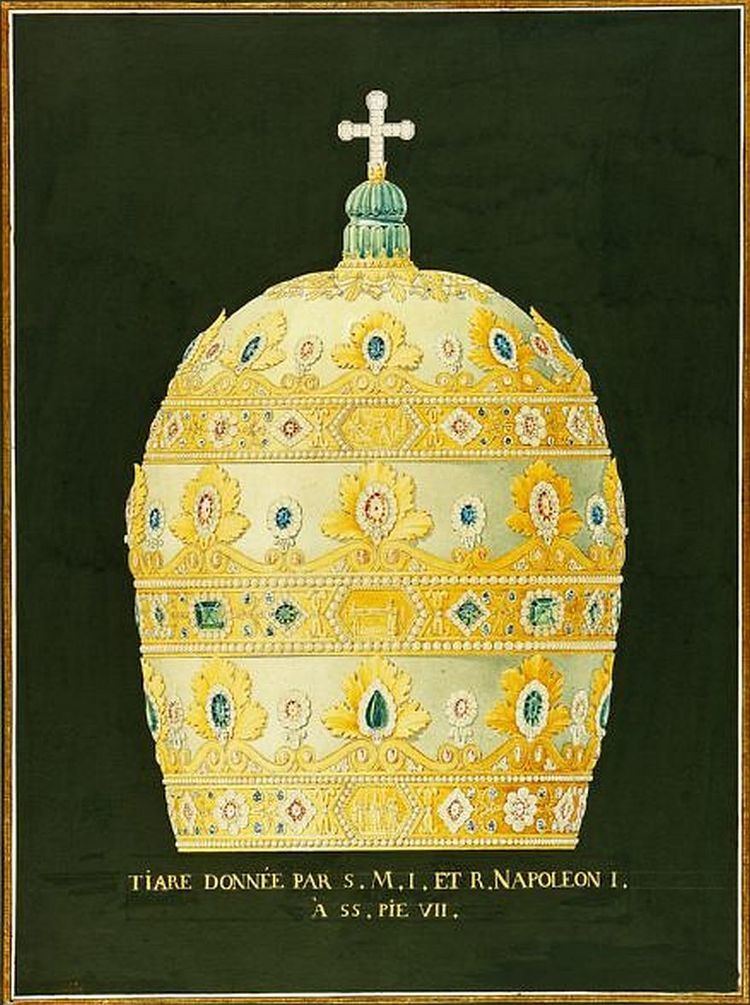 | ||
The Napoleon Tiara was a papal tiara given to Pope Pius VII in June 1805 on the occasion of the coronation of Napoleon I and Joséphine de Beauharnais. While lavishly decorated with jewels, it was deliberately too small and heavy to be worn and meant as an insult to the pope.
Contents
Design
The tiara, which was of traditional papal tiara design, was designed and manufactured by Henri Auguste and Marie-Étienne Nitot of the House of Chaumet in Paris. On a central structure of white velvet there are three crowns of gold, each consisting of a large hoop surmounted with flower-work of wrought leaves, enriched with rubies, emeralds, and sapphires and surrounded with brilliants on a setting of matched and chosen pearls. In total, the tiara included 3,345 precious stones and 2,990 pearls. It cost 179,800 francs.
During the insurrection of 1831, the tiara was buried in Vatican Gardens and suffered great damage as a result. It was restored in 1834–34. The Vatican adjusted the size of the tiara so that it could be worn. It was used as the coronation tiara for a number of popes, most notably Pope Pius IX on 21 June 1846. The Napoleon Tiara was last worn during the First Vatican Council in 1870. With the exception of the emerald and 8 rubies in the monde, all the jewels were removed and replaced by replicas made of coloured glass on the orders of Pope Benedict XV. The jewels were then sold to raise money for the victims of the First World War.
Insult
At his coronation, Napoleon promised to send the pope an altar, two ornate ceremonial coaches, and a tiara. Only the tiara was actually delivered. Tiaras traditionally weighted between 2 and 5 pounds (0.91 and 2.27 kg). The Napoleon Tiara, however, weighted a hefty 18 pounds (8.2 kg). It was also too small to fit comfortably on a human head. Some of the jewels and decoration for this tiara came from earlier tiaras smashed and stolen by the troops of the French Directory in 1798. General Louis-Alexandre Berthier invaded Rome, established Roman Republic, abolished the Papal States, and exiled Pope Pius VI. Due to the destruction of the tiaras, Pope Pius VII had to use the improvised papier-mâché tiara for his coronation in 1800. The great emerald, which Pope Pius VI had to remove from his tiara in order to pay the war reparations per the Treaty of Tolentino, was placed on the tiara in the monde. The emerald (404.5 carats) was originally part of the Tiara of Pope Gregory XIII made by Cristoforo Foppa and displays Gregory XIII's name and coat of arms.
Originally, the middle of the hoop of each crown contained a bas-relief glorifying Napoleon; they represented the re-establishment of worship (repeal of the Civil Constitution of the Clergy), the Concordat of 1801, and Napoleon's coronation. These inscriptions were removed probably by Cardinal Ercole Consalvi, the Cardinal Secretary of State. They were replaced by inscriptions form the scripture: Acts 20:28 at the top, Revelation 11:4 in the middle, and Psalm 85:10 at the bottom. In the painting of The Coronation of Napoleon by Jacques-Louis David, the tiara is held behind the pope by one of his aides; the emeralds are not in the painting. Nevertheless, the pope responded with a thank you letter on June 23, 1805 and said that he intended to use the tiara for the papal mass on the Feast of Saints Peter and Paul.
